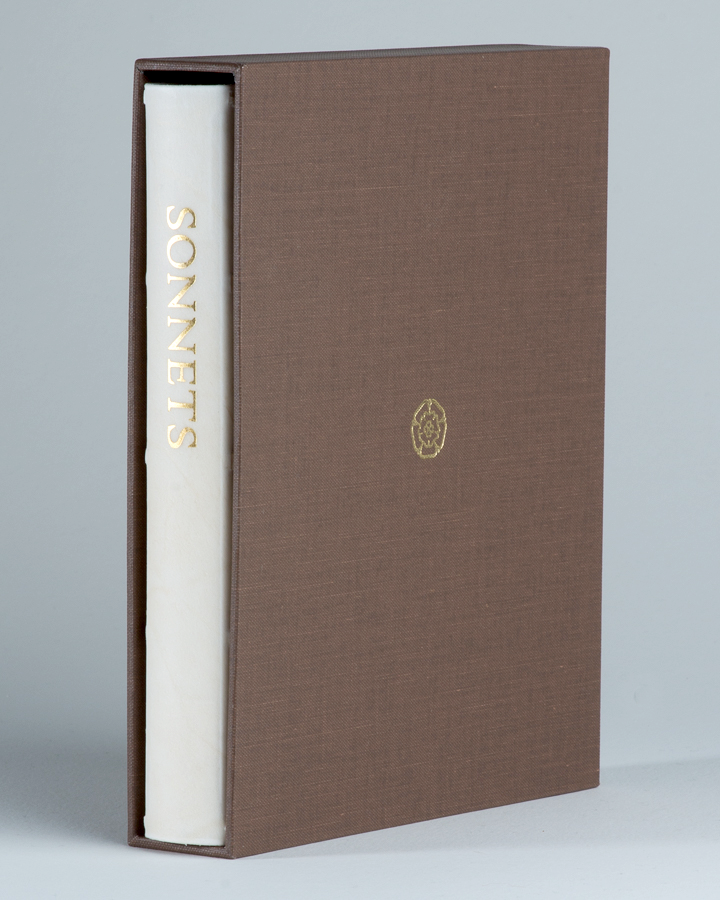
The Most Authentic Text in a Fine Press Edition
The Petrarch Press edition of Shake-speare’s Sonnets has been the most significant project in our history — both for the end result and for the new skills and capabilities we developed along the way. The decision to print the original text was itself a journey of discovery, in which we abandoned our initial plan to issue (yet another) modernized edition of these timeless poems, and learned to appreciate the orthography of Shakespeare’s day. On the technical side, we acquired equipment to cast our own metal type and material for the book, as well as tools for engraving the special characters needed to print a 17th-century text. Adapting the traditional limp vellum binding to a fine-press book was the final challenge.
This edition of Shakespeare’s sequence of sonnets honours the Quarto impression of 1609, perhaps the last publication of Shakespeare’s writings in his own lifetime. We have chosen to respect the arrangement, orthography, and punctuation of the original, with all its peculiarities, the only significant departure being to give each poem a page of its own. In all other ways we have tried to present the most authentic version of the Sonnets possible, in both typography and content, for our modern age.
The Quarto’s Capitals and Italics – Rose, Adonis, Helen, Muse, Pen and Majesty – all stand as they were first printed. The original punctuation is retained, supporting the rhetoric and resonance of Shakespeare’s verse, allowing the reader to feel each line as a breath. Our emendations to the Quarto text are few, and limited to correcting errors that ran counter to the sense. Wherever there was significant doubt as to a proposed correction, we stayed on the side of caution and left the original undisturbed.
The 1609 Quarto, for all its idiosyncrasies, remains the wellspring from which all study of the Sonnets flows. And how may this study continue beyond, perhaps, the conventions of the fair youth, the dark lady, and the rival poets? With this fresh canvas for Shakespeare’s most intimate and mysterious poems, it is our wish that this edition will instil a renewed appreciation both for the music of each individual sonnet and the Sequence as a whole, as well as engender a search for new readings into the struggle of an individual soul to find and affirm his personal identity.
The pages of this edition were set by hand in Cloister Old Style from type cast at our own foundry. The original Elizabethan long-S character and its ligatures, absent from the font, were newly designed, engraved, and cast to match Cloister’s Jenson-inspired characteristics. The initial of the first sonnet is printed with gold leaf.
The sheets of handmade paper and English parchment were printed on our 1851 Super Royal Albion handpress, and all copies are bound in vellum. The volume contains 174 pages, measuring 5.25 x 6.25 inches (13.4 x 15.9 cm), with each sonnet presented on its own page.
Seventy-five copies were printed on Twinrocker handmade paper cast especially for this edition. Twenty copies of these masterworks were printed on English sheepskin parchment.
Related:
Editing Shake-speare’s Sonnets
Creating the Types for Shake-speare’s Sonnets
Shake-speare’s Sonnets
The Petrarch Press, 2015
5¼ x 6¼ inches; pages xvi, 158.
EDITIONS
The Petrarch Press
PO Box 488
9690 Stackhouse Lane
Oregon House, CA 95962
U.S.A.
+1 (530) 692-9531







1 Comment
[…] The Graphic Arts Collection recently acquired a copy of their Sonnets, for which they cast their own metal type and engraved the special characters needed to print a 17th-century text. http://www.petrarchpress.com/shakespeare-sonnets/ […]